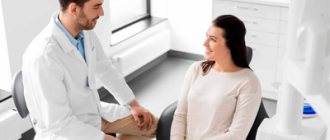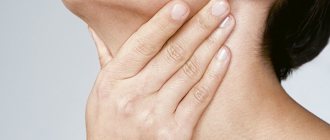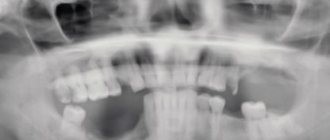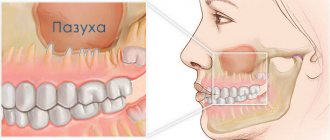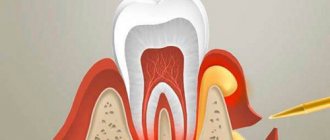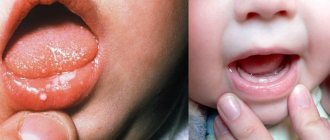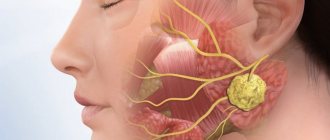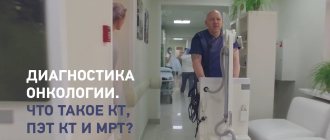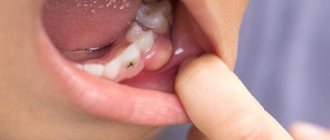Lateral pharyngitis is one of the types of inflammation of the mucous membrane of the pharynx, affecting its side walls located behind the tonsils. The second name of the pathology is lateropharyngitis.
Lateral pharyngitis has symptoms similar to classic pharyngitis, and it is extremely difficult for a non-doctor to determine it. Inflammation may be unilateral or bilateral. When affected, the patient experiences redness and swelling of one lateral ridge or both. The general symptoms of the disease are in many ways similar to the catarrhal manifestations of tonsillitis. In children they are brighter, and the intoxication of the body is stronger. Treatment of the disease must be carried out by a doctor. Self-therapy with home methods greatly increases the risk of complications.
Causes
The causes of lateral pharyngitis are tissue damage by pathogenic fungi, viruses or bacteria. In order for a disease to occur, it is necessary not only for the pathogen to enter the throat, but also for the presence of provoking factors that significantly reduce the body’s defenses. The following negatively affects the functioning of the immune system:
- poor nutrition, in which the body does not receive enough necessary substances;
- smoking in active or passive form;
- abuse of alcohol and even light alcohol;
- chronic inflammatory processes in the body;
- presence of carious teeth;
- breathing through the mouth, especially in the cold season;
- viral infections on the legs;
- overwork;
- lack of sleep;
- chronic stress;
- emotional shock;
- living in areas with unfavorable environmental conditions;
- regular consumption of very hot food and drinks, which causes a drop in local immunity;
- taking medications that reduce the activity of the immune system (such drugs are required for a number of autoimmune diseases).
In children, the problem occurs somewhat more often than in adults, since the child’s immune system is not yet mature and cannot sufficiently resist viruses, bacteria and fungi.
Doctors also identify advanced catarrhal pharyngitis, which affects the back wall of the pharynx, as a fairly common cause of the disease. Taking this into account, the classic form of the disease should be fully treated by seeking medical help.
Treatment for neck pain
For each patient, treatment tactics are developed strictly individually based on the diagnosis, the severity of pathological changes, the presence of concomitant diseases and other factors. Even patients with the same disorders may be prescribed different treatments, since even age and level of physical development influence it.
Nevertheless, the treatment of diseases that cause neck pain is always complex and includes both symptomatic and etiotropic therapy. In other words, it is aimed at eliminating both the symptoms of the disease and the causes of its occurrence. The main components of therapy are often:
- drug treatment;
- osteopathy;
- manual therapy;
- massage;
- physiotherapy (phonophoresis, carboxytherapy, ozone therapy, RF current pressure therapy);
- individual sessions with a rehabilitation specialist.
When diagnosing pathologies of the cervical spine, it is recommended to make some adjustments to your lifestyle and habits. Thus, office workers, drivers, seamstresses and representatives of other sedentary professions are recommended to stretch as often as possible and avoid long-term forced body positions, especially ones that require tension in the neck muscles.
It is also important to eat properly so that the body receives all the substances it needs. This will not only slow down the progression of pathology, but will also contribute to faster regeneration processes.
In case of severe pain, the chiropractor may recommend that the patient purchase a neck brace or Chance collar. Wearing it will help relieve the load on the cervical spine and avoid making thoughtless sudden movements, which will lead to a gradual fading of the pain syndrome. In our center you can select and purchase a bandage that suits you
Before visiting a doctor, in order to reduce pain, you can wrap your neck with a woolen scarf or take a painkiller tablet no later than 12 hours before your appointment.
Drug therapy
The nature of the prescribed drugs and their quantity can vary within very wide limits, which directly depends on the diagnosis and the presence of concomitant diseases. Therefore, we list only those groups of drugs that are prescribed to the vast majority of patients:
- NSAIDs are nonsteroidal anti-inflammatory drugs that also have analgesic properties (produced in various dosage forms, including tablets, ointments, injection solutions, etc.);
- corticosteroids are drugs with a powerful anti-inflammatory effect, which are used only in cases of severe inflammatory processes that cannot be eliminated by NSAIDs;
- muscle relaxants - medications that eliminate muscle spasms of various origins, which helps reduce the severity of pain;
- chondroprotectors are drugs that promote the restoration of the cartilage tissue that makes up the intervertebral discs, but are effective only in the initial stages of the development of osteochondrosis. To prevent diseases of the musculoskeletal system, we recommend to our patients the most effective drug Mermaids Marine Collagen;
- B vitamins - are used to improve the conductivity of bioelectric impulses from the spinal cord to the corresponding organs and restore their proper functioning;
- Vitamin D is a remedy responsible for the condition of bone tissue, as well as for higher brain functions, such as memory, memory, attention, and speech.
Patients may also be prescribed antibiotics, hormone replacement therapy, antihypertensive drugs, and others.
For particularly severe pain in the neck, blockades are used. The procedures involve the injection of anesthetic solutions with corticosteroids into the area where the nerves pass in the neck, which allows for very quick pain relief. But, in addition to the fact that they are effective only for pain caused by nerve damage, they require a high level of professionalism from medical workers, since when performing a blockade there is a risk of injuring the nerve, causing infection and causing serious complications.
Manual therapy
Manual therapy is one of the most effective ways to combat neck pain and the causes of its occurrence, but only if carried out correctly. It involves a direct impact on the spine and surrounding soft tissues. Do not confuse manual therapy with therapeutic massage, which only works the muscles of the back and neck.
Techniques and methods of manual therapy allow literally after the first session to achieve a significant improvement in well-being, and ultimately complete remission. This is achieved through:
- restoration of the normal axis of the spine by returning the vertebrae to their anatomically correct position;
- increasing the distance between the vertebral bodies and releasing compressed nerves and blood vessels, which helps eliminate signs of radicular syndrome, improve the functioning of internal organs and especially the brain;
- elimination of spasm of neck muscles and functional blocks, which improves mobility and reduces pain;
- improving blood circulation and tissue nutrition.
We do not have general standards of treatment; we apply an individual approach to each patient. You should trust manual therapy only to a highly qualified specialist. Otherwise, the use of inappropriate techniques can only harm the patient, aggravate the problem, or provoke the development of complications.
Physiotherapy
Physiotherapeutic procedures are used to increase the effectiveness of the therapy. They are indicated exclusively outside the acute period and have an analgesic, anti-inflammatory effect, and also improve microcirculation in soft tissues and help normalize muscle tone.
Typically, courses consisting of 8-15 procedures are prescribed. It can be:
- electrophoresis;
- UHF;
- ultrasound therapy;
- laser therapy;
- traction therapy (spinal traction);
- mud baths, etc.
The number of sessions of physiotherapeutic procedures and the frequency of their implementation are selected by the doctor individually. Some procedures can be combined with each other, while others should be performed strictly at a certain interval.
Exercise therapy
Physical therapy is one of the mandatory components of conservative therapy for neck pain. Since very often they occur against the background of muscle overstrain and the resulting degenerative-dystrophic processes in the intervertebral discs, it is important to pay due attention to exercise therapy and practice daily.
For each patient, a physical therapy program is developed separately by a rehabilitation physician. Using complexes presented on the Internet can be dangerous, since they do not take into account the individual characteristics of the patient, his age, the degree of neglect of the pathological process and the level of physical fitness of the patient. Therefore, to develop a physical therapy program, the help of a specialist is required. Moreover, the first few classes must be carried out under his supervision, so that the patient can understand how to perform each exercise and does not harm himself in the process of independent training. You should exercise at home in a calm environment, avoiding any sudden movements, and if pain occurs, you should consult a doctor.
Thus, neck pain is a widespread phenomenon. They can be caused by the development of various diseases, but most often the cause of discomfort is problems with the spine caused by a sedentary lifestyle. Therefore, you should not hesitate to consult a doctor. Indeed, in the early stages of the development of the disease, it can be easily dealt with using conservative methods. While in advanced cases, neck pain and the causes that cause them can be eliminated exclusively through surgery.
5 1 vote
Article rating
Kinds
The disease can be acute or chronic. The second type is much more difficult to eliminate, since with it the damage to the mucous membrane is more severe and deep.
Also, depending on the clinical picture of the disease, lateral pharyngitis is divided into three types.
1. Chronic lateral pharyngitis, atrophic. During the disease, the mucous membrane becomes thinner, and the lymphoid tissue is partially replaced by connective tissue. The mucous membrane is hidden by epithelial tissues, some of which are prone to keratinization and peeling. This type of disease is difficult to treat. In advanced forms, only maintenance therapy is possible, which minimizes discomfort in the throat and reduces the likelihood of complications.
2. Subatrophic. It is often called not an independent form, but the first stage of atrophic lateral pharyngitis. The patient experiences diffuse damage to the pharyngeal mucosa, against which tissue atrophy develops. With such a lesion, treatment can completely solve the problem.
3. Hypertrophic. Against the background of pathology, the mucous membrane becomes loose and thickened. There is also a dilation of the vessels of the mucous membrane and an increase and thickening of the lymphoid nodules.
Depending on what type of problem is diagnosed, the treatment of the pathology is selected. The sooner a patient seeks medical help, the higher the likelihood that the disorder will be completely eliminated.
During pregnancy
During the period when a woman is carrying a child, against the background of hormonal changes, a sharp decrease in immunity occurs. This is a normal and necessary process that ensures the preservation of pregnancy, since without it the body’s natural protective barrier will recognize the fetus as a foreign object that needs to be removed from the body. For this reason, various viral and bacterial throat infections are becoming a fairly common problem. For some women, classic or lateral pharyngitis is a constant companion of pregnancy.
Since any inflammation poses a danger to the fetus, treatment should be carried out from the first symptoms. Self-medication is strictly prohibited, as it poses a serious danger and can cause serious consequences for the unborn child. In the early stages, due to general intoxication, there is a risk of miscarriage, and in the later stages, there is a risk of premature birth. It can also cause disturbances in the development of the child, both physical and mental.
In children
In childhood, the problem often appears and poses a threat, especially for children under 3 years of age. In them, due to the structural features of the nasopharynx, even mild swelling can cause suffocation. Also, intoxication at an early age is much more difficult to tolerate, which is why the child may develop convulsive seizures. With a significant increase in temperature due to pharyngitis, hospitalization is most often indicated for children under 3 years of age.
Pain, which is much stronger with lateral inflammation than with damage to the posterior wall, leads to loss of appetite. In some cases, this is the first symptom of the disease, a few hours after which an increase in temperature and other manifestations of pathology are observed.
Causes of pain in the neck muscles
There are several types of pathological conditions that, among other unpleasant symptoms, can lead to pain in the front of the neck under the chin.
Spinal diseases
This includes, first of all, osteochondrosis - one of the most common painful conditions affecting a huge number of the population. At risk are office workers, older people, women during and after menopause. Other common pathologies are spinal disc herniation or protrusion. They are a consequence of rupture of the fibrous ring surrounding each individual vertebra. These diseases cause a person severe constant pain (sometimes not even relieved by anti-inflammatory drugs), and if left untreated, they quickly progress and lead to disability.
Inflammatory diseases of the neck
Inflammation that occurs in the organs located under the muscular frame of the neck is one of the most common reasons why a person has pain in the neck in front under the chin. Usually, malaise is a consequence of viral diseases that affect the trachea and other organs of the upper respiratory tract, but sometimes the disease develops as a result of the pathogenic activity of infectious microorganisms.
Poor blood supply to the neck muscles
The reasons for this condition can be very diverse: sometimes it is only a temporary disorder (as people say, “the neck gets stiff” when being in the same position). In other situations, normal blood circulation becomes impossible due to the appearance of plaques on the inner surface of the vessels (atherosclerosis), and in some cases, pain in the neck under the chin is a consequence of pinched nerve endings.
Hereditary diseases of the muscular system
Diseases transmitted by inheritance often manifest themselves in early childhood and, in the absence of therapy, can “grow” with new symptoms. For example, muscular torticollis, a congenital disease, is diagnosed in infants already at the age of several weeks and is characterized by asymmetry of the face and head, and skeletal deformation. Often, as a result of torticollis, the neck hurts under the chin.
What not to do
There are several common mistakes, by making which the patient puts his health at risk. Doctors categorically prohibit the following in case of illness:
- warming up the throat - the procedure is extremely dangerous, as it can contribute to the rapid spread of the inflammatory process, which is why there is a high probability of developing an abscess, phlegmon and sepsis;
- rubbing the throat area with vinegar or preparations containing alcohol is similar to warming;
- smoking during therapy - nicotine leads to serious damage to the mucous membrane, because of which, if you do not stop smoking, at least for the duration of the illness, treatment will be useless;
- the use of oil to treat the mucous membrane - by forming a film on its surface, oils only aggravate the condition, creating a favorable environment for pathogens;
- the use of alcohol infusions for gargling, since alcohol is a strong irritant to the throat, which will only further injure the mucous membrane;
- non-compliance with diet during treatment;
- self-medication.
Any violations in the treatment of the disease can lead to severe complications. If the patient does not comply with medical recommendations, then the specialist involved in treatment cannot guarantee a positive result.
Treatment
Conservative therapy
The list of therapeutic measures is determined by the nature of the pathology:
- Fractures of the lower jaw
. A linear fracture of the body without displacement is an indication for double-jaw wire splinting. The patient is recommended a gentle diet. In the first days, painkillers are prescribed; for open injuries, antibiotics are used. - Purulent processes
. The skin around the outbreak is treated with disinfectants and alcohol solutions. Antibacterial drugs are selected taking into account the sensitivity of the pathogen. The treatment regimen includes anti-inflammatory drugs, immunomodulators, immunostimulants, and vitamin complexes. - Neuralgia
. The basis of treatment is anticonvulsant medications, which, to increase effectiveness, are combined with medications to improve microcirculation, antispasmodics, antihistamines and therapeutic blockades. - Dental diseases
. Host local events. According to indications, it is recommended to take antibiotics and analgesics. - Atypical prosopalgia
. Tricyclic depressants and anticonvulsants (both separately and as part of complex therapy) provide good results. For intense pain, botulinum toxin is injected to temporarily reduce sensitivity. - Stylohyoid syndrome
. NSAIDs, sedatives, blockades with corticosteroids and local anesthetics, ultraphonophoresis with hydrocortisone are prescribed.
